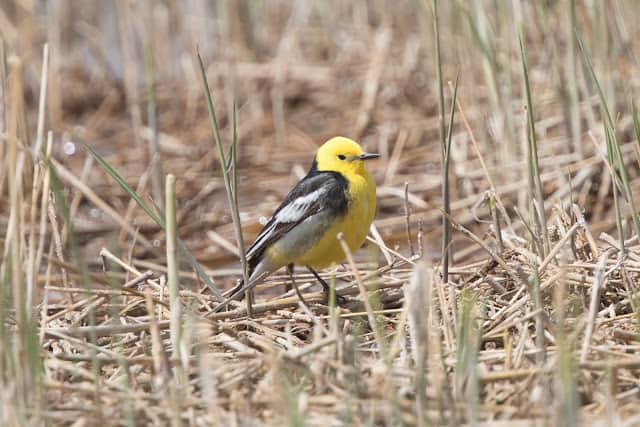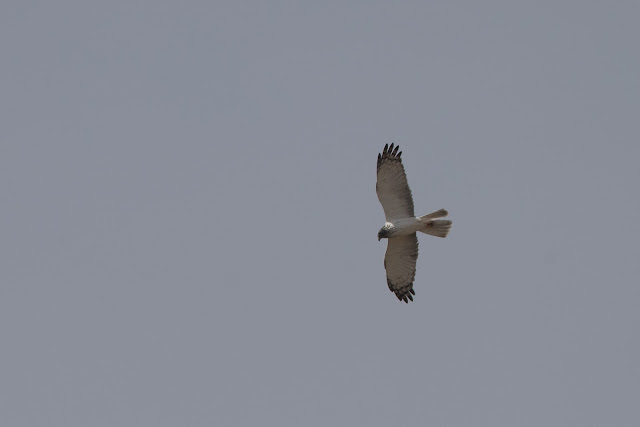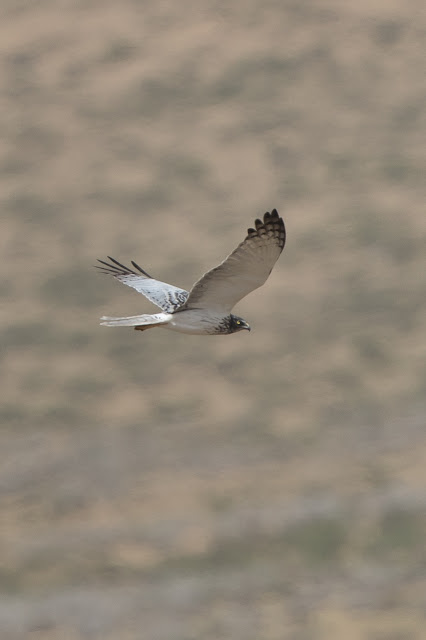Arriving at Bayan Nuur from Sangiin Dalai Lake it was immediately apparent that this lake was teaming with birdlife even though it was blowing a gale. Almost the first birds we picked up were a pair of stunning White-naped Crane on the far hillside with another pair closer in the reeds, we saw nine in all and had some very good views.
Two pairs of Eastern Marsh Harrier patrolled the reed beds. Hundreds of Citrine Wagtail and Eastern Yellow Wagtail foraged within the vegetation occasionally giving good views while hundreds of Barn Swallow of the subspecies tyleri with a good number of the rufous race saturata, Pale Martin and House Martin foraged back and forth over the reedbeds.
Waders and wildfowl included Red-crested Pochard, Swan Goose, Red-crested Pochard, Garganey, Long-toed Stint, Temminck’s Stint and Ruddy Shelduck. We had lunch sheltered from the increasing wind by the vehicles when Tumen announced that he had seen and photographed a Brown Cheeked Rail– a new bird for many of us including Jon. So, after downing our pot-noodles we waded through the reeds and mud to the spot where Tumen had seen the rail.
The rail soon showed to us all and was somewhat unremarkable being barely distinguished from our Western Water Rail both in plumage and in voice – it was once considered a subspecies of Western Water Rail.
Also here were Bearded Reedling of the race russicus which looked remarkably pallid, Yellow-browed Warbler, Pallas’s Warbler and Reed Warbler plus a male Japanese Sparrowhawk that regularly zipped through disturbing all the birds. Way too soon it was time to head off and as we drove north we ran into a significant sand storm stirred by the strong winds.
Citrine Wagtail – Bayan Nuur
Citrine Wagtail – Bayan Nuur
Eastern Yellow Wagtail of subspecies macronyx – Bayan Nuur
White-naped Crane – Bayan Nuur
White-naped Crane – Bayan Nuur
White-naped Crane – Bayan Nuur
White-naped Crane – Bayan Nuur
White-naped Crane – Bayan Nuur
White-naped Crane – Bayan Nuur
White-naped Crane – Bayan Nuur
White-naped Crane – Bayan Nuur
White-naped Crane – Bayan Nuur
Common Crane – Bayan Nuur
Swan Goose – Bayan Nuur
Greater Spotted Eagle – Bayan Nuur
Greater Spotted Eagle – Bayan Nuur
Greater Spotted Eagle – Bayan Nuur
Eastern Marsh Harrier – Bayan Nuur
Eastern Marsh Harrier – Bayan Nuur
Eastern Marsh Harrier – Bayan Nuur
Eastern Marsh Harrier – Bayan Nuur
Eastern Marsh Harrier – Bayan Nuur
Eastern Marsh Harrier – Bayan Nuur
Eastern Marsh Harrier – Bayan Nuur
Eastern Marsh Harrier – Bayan Nuur
Eastern Marsh Harrier (female) – Bayan Nuur
Eastern Marsh Harrier (female) – Bayan Nuur
Eastern Marsh Harrier (female) – Bayan Nuur
Red-crested Pochard – Bayan Nuur
Horses – Bayan Nuur
Brown-cheeked Rail – Bayan Nuur
Brown-cheeked Rail – Bayan Nuur
Bayan Nuur
Dust storm on the way to Hustai
Roadside village
We arrived at Hustai National Park in the early evening and after paying the park entrance fee, plugged the coordinates for our digs at the research centre into the sat-nav and headed off. We followed dusty tracks through rolling brown hillsides and then the tracks pettered out and we drove onwards, offroad trustingly following the satnav.
A Woodcock was flushed a from roadside scrub as we drove but there were remarkably few birds. Barry and I gave a rolling commentary, 5km to go, 3km to go, 2.3km to go, it must be around the next hill, around the next hill still 2.3km to go, oh, so it must be around the next hill, we rounded the next hill and the satnav said 2.5km to go and then 3km. We had gone wrong and no sign of the accommodation.
We turned around to check we hadn’t simply driven by but still no sign – not easy to miss a research centre on a barren hillside. Not only that but we had lost the other two vehicles and the support vehicle. We turned around and headed back in search of the other vehicles and too our relief found them after around 30 minutes of searching – the support vehicle having run out of fuel while one of the other vehicles having had a puncture.
After repairing tyres and filling up the support vehicle from a jerry-can we headed to a nearby Ger and the residents pointed us in the direction of the research station. It was getting dark and we had been searching for almost two hours, with a local on board we headed into the park through the dark and eventually arrived at some ramshackle huts – we were only 6km from the park entrance where we started and now 15km from the co-ordinates for the orginal research centre, still we were pleased to have found a roof and there were beds and we had vodka – all was good and today had been one of the best birding days of the trip.
Hustai is a pretty barren looking National Park
Its that way
Time for Vodka
Simon Colenutt
I began birdwatching at the age of nine when living on the Isle of Wight. After obtaining a copy of the Isle of Wight Bird Report from 1976 I realised that Manx Shearwater, Arctic Skua, Pomarine Skua and Black Tern were regularly seen at St.Catherine's Point, only five miles from my home village of Chale Green. To a nine year old these birds were near mythical and so I just had to go and try to see them. Little did I know that these birds were seasonal and after a long winter of seeing nothing I eventually started to bump into other birdwatchers as March drew to a close. It was then that Dave Hunnybun, Dave Wooldridge, Paul Castle, Peter Gandy and Audrey Wilkinson introduced me to the art of seawatching and the joys of bird migration, I have not looked back since.







































Leave a Reply